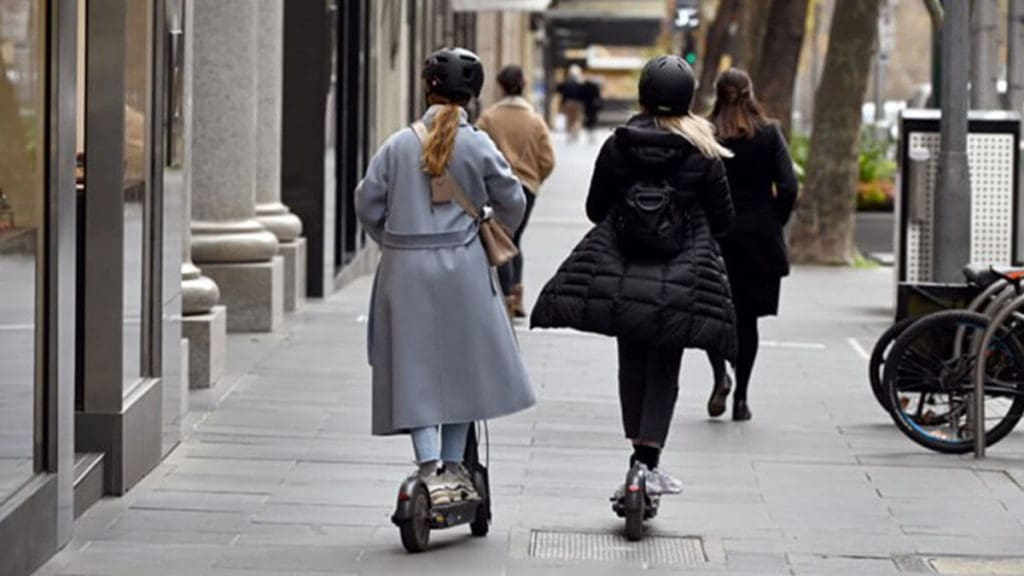What’s the Future of Micromobility in Australia?

![]()
By Justin McCulloch*
Over the past five years, Australia has had a strained relationship with micromobility. We’ve seen everything from the ongoing COVID-19 bicycle boom, to the rise, fall, and return of e-scooters in many cities around the country, to street trees and rivers being used as parking for cheap dock-less bicycles.
Whether it’s because of the persistence of shared micromobility providers in the Australian market, or the knowledge that stepping away from car ownership is good for the environment, the economy, and ones’ health, I believe we can confidently say that micromobility – in one form or another – is here to stay.
First, it is important to define micromobility. Broadly, micromobility encompasses small form-factor Connected, Autonomous, Shared, and/or Electric (CASE) vehicles, typically weighing less than 277kg and less than 1.5m wide. E-scooters and bicycles are currently the most common form of micromobility, however vehicles such as Segways, hoverboards, mopeds, and mobility scooters are also classed as micromobility vehicles. Personal Mobility Devices (PMDs) and shared micromobility provides several benefits to the rider and the city broadly, including greater mobility choice, reduced traffic congestion, direct cost savings via reduced spending on vehicle costs, environmental benefits, and health benefits.
Last year saw people buying bicycles in droves, with many retailers selling out of children’s bicycles and a sharp increase in the number of women cycling. I should specify that most of these bikes have been used primarily for recreational purposes – poor infrastructure and perceptions of safety continue to impede utility cycling rates. Dr Robbie Napier argues that one way to increase utility cycling is by way of the design of the bike, moving away from sports bikes with carbon fibre frames and aggressive geometries, towards utility and cargo bikes, with the capacity to transport luggage and other passengers. Many look to ride-sharing as the answer to urban mobility woes, particularly as an avenue to Mobility-as-a-Service (MaaS), which includes bike and e-scooter sharing as a key component of the first/last-mile problem.
Bike and Scooter Sharing
I view micromobility as a key component of future urban mobility. My research focuses on the ongoing transformations and transitions concerning bike and e-scooter sharing services in Australia.
Whilst the topic gained prevalence in 2017 with the introduction of dockless bikes provided by Chinese operators ofo, Reddy Go and Mobike, and Singaporean oBike, Australia’s experience with shared bikes first started in 2005 with Adelaide Free Bike, a publicly funded scheme popular with tourists, followed by Melbourne Bike Share and Brisbane CityCycle in 2010, Australia’s first commercial docked bikeshare schemes. Unfortunately, Melbourne Bike Share was scrapped in 2019 due to a perceived lack of use and Brisbane CityCycle is currently being decommissioned and is to be replaced with a semi-dockless e-bike scheme later this year. E-bikes have the potential to succeed where CityCycle struggled by offering a more flexible mobility option with a wider appeal than pedal cycles or e-scooters, which leads Griffith University PhD Candidate, Madison Bland, to support the roll-out of e-bikes in Brisbane.
Shared e-scooters have become a common sight in a growing number of cities around the country. Constant competition keeps providers like Lime, Beam, and Neuron engaged in innovating their services to provide the best possible ride for their customers, and as operations expand regulations too adapt. E-scooters, and indeed other forms of electric PMDs sit in a strange legislative limbo, depending upon where you are, and how PMDs are classed under the Australian Road Rules. South Australia, Queensland and the Australian Capital Territory are the only states and territories to have legislated guidelines on what e-scooters and other PMDs are defined as, and how they are to be used on public roads, and of these the ACT is alone in having guidelines for the use of personal PMDs.
Micromobility providers are constantly innovating to stay on-top of the competition. Spin, an e-scooter operator, are developing a remote controlled e-scooter which can be redistributed without the need for a group of employees roaming the city in rental vans, which reportedly has the capacity to increase the number of rides per scooter per day tenfold through improved rebalancing of the fleet and the potential for a scooter to be available on demand. Whilst there are clear benefits for the user, there are some concerns about the automation of a fleet and the need to reskill employees, as well as continuing health concerns around shared devices and helmets.
Lime have also continued their campaign for climate justice and an unbundling of car-ownership, now announcing the Lime Moped, joining a growing number of operators in Europe and South East Asia who offer shared electric mopeds.
So what is actually next for Australia? E-bikes are becoming a more frequent sight, more cities are investigating bike and e-scooter sharing schemes, and the National Transport Commission (NTC) is currently assembling a proposed, consistent legal framework for PMDs across the Commonwealth.
Micromobility is on the rise across the country, and throughout the rest of the world, but what remains to be seen is how Australia can step away the car and start looking towards the first and last mile.
Will it be a generational change? A critical mass of infrastructure projects? A wider range of modes to choose from?
Perhaps all the above?

* Justin McCulloch is a transport geographer and PhD candidate at the University of South Australia, researching the ongoing transitions of dockless rideshare schemes around the world.
Justin has an ongoing research interest in how cycling infrastructure helps cultivate suburban areas as cycling places, and how urban spaces can be designed with the most vulnerable in mind. He is the inaugural convenor of his local Bicycle User Group and the program manager of the Australian Walking and Cycling Conference.
He can be found on twitter at @jf_mcculloch

Great reflection Justin! It certainly is an evolving and dynamic space that has so much potential for revolutionary change for Aus mobility.
For mine, I think it’s strongly linked with availability of choice and maximisation of convenience for the public. All micromobility options could potentially compliment each other, however, it’ depends on how they are supported by a regulatory frameworks that prioritises safe and efficient movement.
P.S. Thanks for the mention, I’ll hopefully look forward to more insightful pieces from yourself.